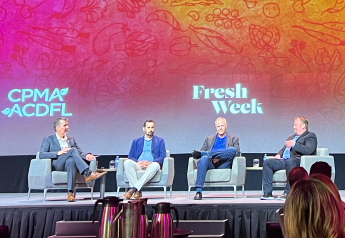Eastern apple growers optimistic despite early frost, dry spell

This year, East is West, where apples are concerned.
That's because a drought has settled in across New York and other parts of the Eastern apple growing region.
"In general, I think everybody is feeling pretty good about how clean this crop can be. We had West Coast growing conditions - arid," said David Benner, general manager of Fairfield, Pa.-based El Vista Orchards.
As of Aug. 4, nearly half of New York was in moderate to severe drought, and nearly half of the state was rated as "abnormally dry," according to the National Drought Mitigation Center.
The center reports that rainfall deficits from early May to early August were 4-9 inches in much of the Northeast.
Accumulated shortfalls over the past two years were 12-24 inches in areas from central New England southward into Northeastern Pennsylvania.
"Every year is a new challenge in the land of climate change," said Mark Russell, grower, vice chairman of the board and chairman of the marketing committee for Wolcott, N.Y.-based Crunch Time Apple Growers.
He called the recent dry spell "unprecedented."
There is some good news, Russell said.
"We have new orchards, and new orchards are irrigated," he said.
Russell also said the heat and dry conditions contribute to good sugar development in apples.
"We should have a sweet crop, great flavor," he said.
The Fishers-based New York Apple Association opted to hold back a forecast for this year's crop.
"Talking about any given year's apple crop before the fruit is actually off the trees can be challenging," said Jim Allen, president and CEO of the association.
Last year, for example, the U.S. Department of Agriculture's final estimate of New York's 2015 crop was 32.5 million 42-pound units - compared to the agency's July 2015 forecast of 26.2 million, Allen said.
New York's record of 32.6 million boxes was in 2009.
Benner said some orchards in North Carolina, Virginia, Pennsylvania and New York had some hail damage, but most growers escaped relatively unscathed.
Richard Seaman, partner in Silver Creek and Seaman Inc., which has 150 acres in Tyro, Va., said he lost 40% to 50% of his crop to a hailstorm in June.
"We've got a bad hail crop, nothing worth talking about," he said.
A lot of it likely will end up in the juice market, Seaman said.
A heat wave in early August was another part of the equation, Benner said.
However, he said "we should have plenty of good apples to satisfy the market."
New York growers have faced challenges most of the year, said Mark Nicholson, executive vice president of Red Jacket Orchards in Geneva, N.Y.
He said frost complicated the bloom season, but the crop survived.
"At this point, everybody's comfortable with the fact that there's a fair number of apples out there," he said.
When the fruit comes in, quality shouldn't be an issue, Benner said.
The drought will affect fruit size, said John Teeple, owner of Wolcott-based Teeple Farms.
"Volumewise, there's still a lot of good apples, but we'll definitely be down from a normal full crop - I'm guessing about 27% less than a normal crop," he said.
Teeple said he'll start picking ginger golds in late August and follow that, in early September, with gala. Mcintosh will start in about the third week of September.
Pennsylvania is anticipating an apple crop of about 10 million bushels, which would be in line with its five-year average, said Julie Bancroft, executive director of the Harrisburg-based Pennsylvania Apple Marketing Board.
Last year's crop was estimated at about 11 million bushels, she said.
"Despite limited impact from weather, we'll have a near full crop and all popular Eastern apple varieties available," she said.
That beats the earliest expectations, said John Rice, president of Rice Fruit Co., Gardners, Pa.
"After a dicey spring with a number of frosty mornings, the Pennsylvania apple crop ended up being much better than the growers expected," he said.
Most fruit buds survived and growers now are expecting about 90% of their normal crops, Rice said.
"Weather since bloom has been generally favorable, but by the end of July was starting to get dry," he said.
Virginia agriculture officials did not provide an estimate on their crop.
"The season is late this year, and the harvest hasn't started yet, so it's difficult to evaluate," said Elaine Lidholm, communications director with the Virginia Department of Agriculture and Consumer Services.
She did say there would be fewer large apples this year.
Henry Chiles, owner of Crown Orchard Fruit Co. in Covesville, Va., said he might end up with two-thirds of his usual crop.
"We lost a little to freeze, but it's sizing good," he said.
Chiles expected to harvest his first galas around mid-August, with fujis and granny smiths around Oct. 1.
As for rainfall?
"Borderline right now, but we've been irrigating," Chiles said.







